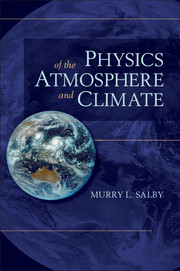Book contents
- Frontmatter
- Contents
- Preface
- Prelude
- 1 The Earth-atmosphere system
- 2 Thermodynamics of gases
- 3 The Second Law and its implications
- 4 Heterogeneous systems
- 5 Transformations of moist air
- 6 Hydrostatic equilibrium
- 7 Static stability
- 8 Radiative transfer
- 9 Aerosol and cloud
- 10 Atmospheric motion
- 11 Atmospheric equations of motion
- 12 Large-scale motion
- 13 The planetary boundary layer
- 14 Wave propagation
- 15 The general circulation
- 16 Dynamic stability
- 17 Influence of the ocean
- 18 Interaction with the stratosphere
- Appendix A Conversion to SI units
- Appendix B Thermodynamic properties of air and water
- Appendix C Physical constants
- Appendix D Vector identities
- Appendix E Curvilinear coordinates
- Appendix F Pseudo-adiabatic chart
- Appendix G Acronyms
- Answers to selected problems
- References
- Index
- Plate section
14 - Wave propagation
Published online by Cambridge University Press: 05 June 2012
- Frontmatter
- Contents
- Preface
- Prelude
- 1 The Earth-atmosphere system
- 2 Thermodynamics of gases
- 3 The Second Law and its implications
- 4 Heterogeneous systems
- 5 Transformations of moist air
- 6 Hydrostatic equilibrium
- 7 Static stability
- 8 Radiative transfer
- 9 Aerosol and cloud
- 10 Atmospheric motion
- 11 Atmospheric equations of motion
- 12 Large-scale motion
- 13 The planetary boundary layer
- 14 Wave propagation
- 15 The general circulation
- 16 Dynamic stability
- 17 Influence of the ocean
- 18 Interaction with the stratosphere
- Appendix A Conversion to SI units
- Appendix B Thermodynamic properties of air and water
- Appendix C Physical constants
- Appendix D Vector identities
- Appendix E Curvilinear coordinates
- Appendix F Pseudo-adiabatic chart
- Appendix G Acronyms
- Answers to selected problems
- References
- Index
- Plate section
Summary
The governing equations support several forms of wave motion. Atmospheric waves are excited when air is disturbed from equilibrium (e.g., mechanically when air is displaced over elevated terrain or thermally when air is heated inside convection). By transferring momentum, wave motions convey the influence of one region to another. This mechanism of interaction enables tropical convection to influence the extratropical circulation. It also enables the troposphere to perturb the stratosphere, driving it out of radiative equilibrium (Fig. 8.27).
DESCRIPTION OF WAVE PROPAGATION
Wave motion is possible in the presence of a positive restoring force. By opposing disturbances from equilibrium, the latter supports local oscillations in field properties. Under stable stratification, buoyancy provides such a restoring force (Sec. 7.3). The compressibility of air provides another. The variation with latitude of the Coriolis force provides yet another restoring force. It will be seen to support large-scale atmospheric disturbances.
Surface water waves
The description of wave motion is illustrated with an example under nonrotating conditions, which will serve as a model of buoyancy oscillations in the atmosphere. Consider disturbances to a layer of incompressible fluid of uniform density ρ and depth H (Fig. 14.1). The layer is bounded below by a rigid surface. It is bounded above by a free surface, namely, one that adjusts position to relieve any stress.
- Type
- Chapter
- Information
- Physics of the Atmosphere and Climate , pp. 416 - 469Publisher: Cambridge University PressPrint publication year: 2012

